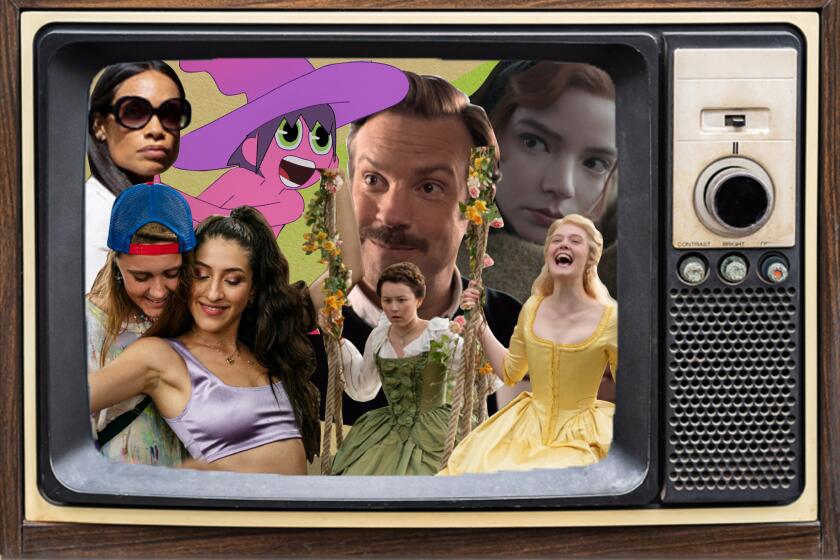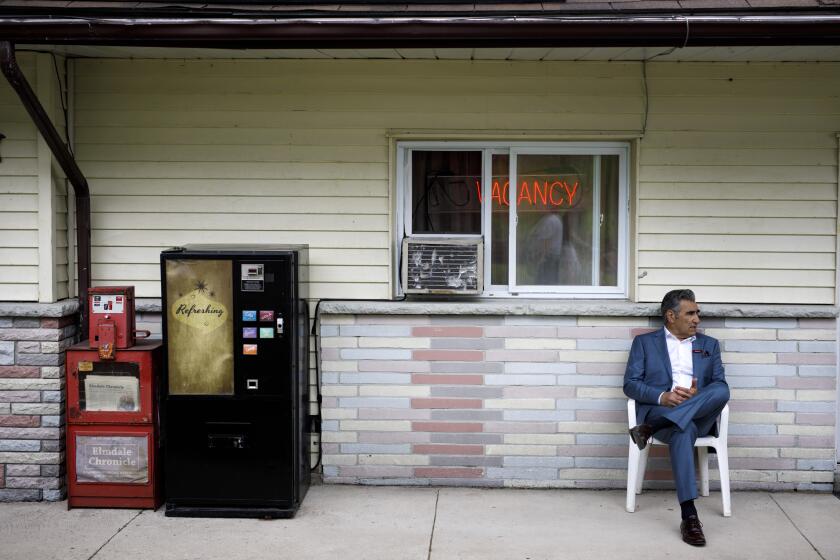Commentary: Pop culture isn’t biased toward ‘coastal elites.’ If anything, it’s the opposite
- Share via
An odd result of both the election Donald Trump won and the one he lost was to raise the question of whether the panjandrums of popular culture were — and are — doing enough for the people who supported — and still support — him. Telling their stories. Respecting their lives. Feeling their pain.
The 2016 election, it’s fair to say, took most people by surprise, including, many believe, the person elected. Among other things, this eleventh-hour upset set Hollywood — which skews to the left — to wonder what it might have overlooked, an audience not merely underserved but also untapped. As in the political media, this business tends to be discussed in dualistic terms: coastal elites versus flyover states, urban versus rural, red versus blue, nonbinary versus super-binary and so on. The real world is more granular and complex, of course; there are progressive farmers and conservative sitcom stars (a few, anyway). There are functional and dysfunctional families in every ZIP Code in the country. And everyone everywhere loves Dolly Parton.
The truth is, film and television have long celebrated country and small-town life and the values that supposedly maintain there: community, faith, proximity to the land, respect for authority, front-porch courting, sack races, corn on the cob. It’s an imaginary construct, at least in part — nostalgia taken for history, engineered in books and movies, pop songs and television shows, built to order on the soundstages and backlots of Southern California. Still standing are Universal’s Courthouse Square (as seen in “Bye Bye, Birdie,” “To Kill a Mockingbird,” “Back to the Future” and “Leave It to Beaver”) and the Midwest Street at Warner Brothers (“The Music Man,” “Dukes of Hazzard,” “Gilmore Girls” and the “Seinfeld” finale, where, stranded in a small town, the cast is put on trial for being, essentially, self-involved big city jerks). You can see them on the studio tours.
The Times TV team reflects on the series that helped us cope throughout a brutal year — and may help you pass the time inside during the pandemic’s long winter.
It’s true too that pop culture has written many love letters to the city. Central Park was about as far up the country as Fred Astaire and Ginger Rogers usually got. Yet when city folk and country folk meet on-screen, the advantage is almost always to the country. When it’s a matter of a fish out of water — Michael Fox in a South Carolina hamlet in “Doc Hollywood,” Martin Clunes in a Cornish fishing village in “Doc Martin,” Rob Morrow as a New York doctor indentured to an Alaska small town in “Northern Exposure,” Rachel Bilson (yet another New York doctor) working as a GP in an Alabama small town in “Hart of Dixie,” and conversely, Paul Hogan’s “Crocodile Dundee,” in from the outback, Dennis Weaver as a New Mexico sheriff keeping Manhattan safe in “McCloud” — the country usually improves the city visitor, while the country visitor typically improves the city. When a city slicker is outfoxed by a country bumpkin, we consider it just, yet we think it unfair the other way around.
The idea that civilization is often uncivil is not nearly new. The tale of the country mouse that visits its city cousin, only to run home to a less luxurious but less dangerous life, goes back to Aesop and has been rewritten many times since; Disney made a cartoon out of it in 1936. In Shakespeare’s “As You Like It,” an exiled duke retreats to the forest of Arden with his followers, “and there they live like the old Robin Hood of England … and fleet the time carelessly, as they did in the golden world.” In the mid-19th century, American readers and theatergoers were titillated by “wicked city” stories, highlighting the sinful temptations of the metropolis, as in Ned Buntline’s novel “The Mysteries and Miseries of New York,” adapted by H.P. Grattan for the stage (“See [it] once and then fly to the country,” one reviewer wrote) and Thomas de Walden’s income inequality drama “The Upper Ten and Lower Twenty.” Crooked politicians, self-indulgent swells, family men and women brought by drink to depravity — that’s what the big city had in store.
Jaded urban operators and hard-boiled women met their match in guileless small-town heroes in the films of Frank Capra. In the Judy Garland musical “Meet Me in St. Louis,” father Leon Ames sparks depression in his family when he announces that they’re moving to New York. That the black-and-white life of a windswept Kansas farm is preferable to the Technicolor pleasures of a land over the rainbow is the central theme of “The Wizard of Oz.” In old westerns, the Eastern dude is ridiculed until he learns cowboy ways — but when the cowboy comes to the city, he is Gary Cooper in “The Cowboy and the Lady,” melting the heart of sophisticated heiress Merle Oberon. At the end, she’s in a kitchen out West, baking her first cake.
In the 1960s, even as the culture progressed from swinging to psychedelic to fighting in the streets, country-themed television shows ruled the airwaves. Set in fictional Mayberry, N.C., “The Andy Griffith Show” featured the star as a wise sheriff and single father to Ron Howard’s Opie; never out of the top 10 across its eight seasons, it led the ratings in its last, 1968, and turned into the Andy-less “Mayberry, R.F.D.” for an additional three. “The Beverly Hillbillies” became the country’s top-rated show within three weeks of its 1962 premiere; the Clampetts might mistake a pool cue for a fancy pot-passer but, like Ma and Pa Kettle in the movies before them, they are pure of heart and smart where it counts. Jed is wise, Granny feisty, Elly May a sunbeam; Jethro’s not quite fatal flaw is that he wants to go Hollywood. In its mirror-image cousin, “Green Acres” — quasi-remade in 2019 as “Bless This Mess” — a New York lawyer following his dream of “farm living” is exasperated by his new neighbors but lacks their practical knowledge and liberating eccentricity.
Los Angeles Times television critic Robert Lloyd chooses the best TV shows of 2020.
Here in the 21st century, countless Hallmark and Lifetime movies, and not just the holiday ones, feature a prodigal returning to the small town from the city — where life was exciting, sure, but never really satisfying, you know? — to remember what matters. That’s also the gist of this year’s Netflix yuletide musical, “Dolly Parton’s Christmas on the Square,” with Christine Baranski as an “it’s just business” businesswoman who intends to turn her old hometown into a giant mall, until her hometown turns her good again.
Love is a determining factor in many of these stories. Country America is associated with a sort of romance novel masculinity; the man of the woods may not read Shelley and Keats, but he can build you a house and catch a fish with his bare hands. (And, these days, he probably also reads Shelley and Keats.) Such was ABC’s 2006 “Men in Trees,” with Anne Heche as a New York expat author getting chummy with plaid-clad Alaskan biologist James Tupper, and such too is Netflix’s popular “Virgin River,” recently renewed for a third season, with Alexandra Breckenridge as a Los Angeles nurse practitioner finding emotional refuge in a Northern California mountain town, where hunky, deep veteran Martin Henderson runs a restaurant-bar where the food is to die for and the drinks mixological. And let it be said that the women in these stories are capable too, tough and independent and as liable as any man to drop a literary reference.
It should be said as well that these created places tend to be more utopian than Trumpian. (Shows that attempt a more or less straightforward view of rural life — the Texas football drama “Friday Night Lights,” say — remain rare.) They are not parochial or nativist but represent a sort of liberal dream of small town life — superficially conservative and fundamentally progressive, steeped in tradition but open to change. There are no boarded-up windows on Main Street: quirky businesses flourish; the coffee at the diner is the best you’ll ever have. The farm is always a family farm, never a factory farm (a satisfying thought to viewers on the right and the left). The population at least suggests ethnic and sexual diversity; folks are friendly to strangers and tolerant of difference. And because television, especially, is aspirational, it tends to live a little in the future, in the better days toward which the arc of history is more slowly bending. “Northern Exposure” held a gay wedding in 1994, anticipating America’s first legal same-sex marriage by nearly a decade and the Supreme Court decision making it legal everywhere by more than two. (Its town, called Cicely, was also cofounded by a lesbian couple.)
Season 6 of “Schitt’s Creek” promises to be emotional. The cast says filming it was plenty hard.
In the end, Trump’s election did not much alter the complexion of major-league television — and the polarizing nature of his presidency did not make that any more likely as time went on — beyond a few more hours of cop shows on CBS and ABC’s 2018 revival of “Roseanne,” one of relatively few series in any era to make economic stress a realistic, significant factor in its characters’ lives; that it was set among a white working-class family seemed made to order for the moment, though the revival also gave D.J. an African American wife and biracial daughter and Darlene a gender-fluid son. It was, indeed, a hit, which did not save it from cancellation after star Roseanne Barr, an actual Trump supporter and an avid conspiracy theorist, tweeted a racial slur. The series subsequently was retooled as “The Conners,” minus Barr; its third season began in October.
And there was the odd brave personal project, like W. Kamau Bell’s “United Shades of America,” which premiered on CNN while the 2016 election campaign was in progress, and Sarah Silverman’s “I Love You, America,” which went up on Hulu in the first year of the Trump administration, that attempted some kind of bridge building, as leftist comedians traveled from the coasts to meet and possibly find some common ground with people across the chasm. It all seems so quixotic now, the notion that television could be an instrument of understanding, even of healing.
And yet, you never know. “Schitt’s Creek,” which landed a formerly wealthy family in a small town whose nominally strange residents were for the most part less eccentric than themselves, grew increasingly popular across its six seasons and swept the Emmys earlier this year. Acceptance is very much its watchword, love the reward: The series, which proposes a world without homophobia, ends with the wedding of co-creator and costar Dan Levy’s David Rose to boyfriend Patrick Brewer (Noah Reid).
“Some of the most touching feedback I’ve received has been from right-wing religious-based people who have never understood queer culture,” Levy told The Times in 2018. “If we can continue to open people’s eyes to realize that everyone’s deserving of love, that’s a wonderful thing.”
More to Read
The complete guide to home viewing
Get Screen Gab for everything about the TV shows and streaming movies everyone’s talking about.
You may occasionally receive promotional content from the Los Angeles Times.









